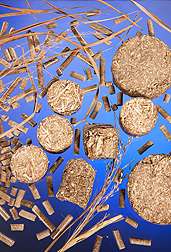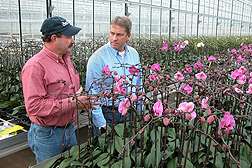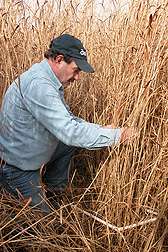A study of switchgrass for home heating in the Northeast

(Phys.org) —President Barack Obama wants U.S. scientists to pursue an "all-of-the-above" strategy in developing new sources of domestic energy. Agricultural Research Service agronomist Paul Adler is providing complete cost-benefit breakdowns for using switchgrass pellets instead of fuel oil to heat homes and businesses in the Northeast.
"There have been a lot of studies on bioenergy potential," says Adler, who works at the ARS Pasture Systems and Watershed Management Research Unit in University Park, Pennsylvania. "Most of them are focusing on transportation, but we still need a viable, commercial, biobased fuel substitute for petroleum. In the meantime, our studies suggest that we already have opportunities to use homegrown feedstocks for producing heat, and that we can save money, reduce petroleum use, and cut greenhouse gas production in the process."
Adler and others conducted a life-cycle assessment comparing costs of energy generation from coal, natural gas, fuel oil, and switchgrass in the form of energy-dense cubes, briquettes, and pellets. His research partners included ARS technician Fred McNeal, Pennsylvania State University graduate student Tom Wilson, Wilson's advisor David Abler, and Drexel University assistant professor Sabrina Spatari.
The researchers calculated the economic outlays associated with switchgrass production throughout the supply chain and the amounts of greenhouse gases—carbon dioxide, nitrous oxide, and methane—emitted during switchgrass production, densification, and conversion to heat and power. This included the first life-cycle inventory of switchgrass seed production and the greenhouse gas emissions associated with it, which the team developed using real-world information from a Pennsylvania producer.

The analysis indicated that 192 pounds of "carbon dioxide equivalent," or CO2e, were emitted for every ton of switchgrass dry matter that was grown, harvested, and delivered to densification plants for processing into pellets. CO2e is a measurement used to compare the emissions from various greenhouse gases based on their global-warming potential.
More than 54 percent of these emissions were from nitrous oxide resulting from nitrogen fertilizer application, while farm equipment operation also produced substantial levels of greenhouse gases. Processing each ton of dry matter into pellets generated another 287 pounds of CO2e; 78 percent of these emissions stemmed from grinding and pelletizing processes, with the remainder coming from the drum dryer.
Feel the heat
With these findings in hand, the researchers calculated that using switchgrass pellets instead of petroleum fuel oil to generate one gigajoule of heat in residences would reduce greenhouse gas emissions by 146 pounds of CO2e. Using switchgrass pellets instead of natural gas to produce one gigajoule of heat in residences would reduce greenhouse gas emissions by 158 pounds of CO2e.
Substituting switchgrass pellets for fuel oil for home heating would also save money. Totaling all costs associated with installing an appropriate residential heating system and fuel consumption, Adler's team concluded that each gigajoule of heat produced using switchgrass pellets would cost $21.36. Using fuel oil to produce the same amount of heat would cost $28.22. The savings would be less in a commercial facility, because capital costs for a commercial biomass boiler, storage, and fuel-handling equipment are five times greater than the costs for components that use fuel oil.

According to the team's calculations, heating with switchgrass pellets would continue to be less expensive even if switchgrass production costs rose 200 percent and the price of fuel oil dropped 70 percent. These findings are based on the average heating-oil price from the 2010-2011 heating season, which was $0.90 per liter. But even if fuel-oil prices dropped to their 10-year average of $0.62, it would still cost less to generate a gigajoule of heat using switchgrass pellets.
Coal is a somewhat different story. Although substituting biomass for coal in electric generation substantially reduced greenhouse gas emissions, it would come at a high cost to domestic consumers. Using coal, it would cost $31.03 to generate each megawatt of electricity, but using switchgrass briquettes would cost $154.62, and switchgrass cubes would cost $156.52. (Briquettes and cubes were used in this series of life-cycle analyses because of their lower energy intensity relative to pellets.) So even though greenhouse gas emissions would drop dramatically by using switchgrass to generate power, these reductions are achieved at a high cost relative to coal—an outcome called "positive abatement costs" that policymakers would like to avoid.
Using projections from the U.S. Department of Energy's "Billion Ton Report," the scientists concluded that by 2022 there would be enough sustainably harvested biomass available in the northeastern United States to offset the entire regional demand for heating oil. This would save consumers between $2.3 and $3.9 billion per year in fuel costs.
It would also reduce greenhouse gas emissions in the Northeast—currently around 885 million tons of CO2e every year—by 5 percent. Many renewable-fuel projects are tasked with finding cost-effective strategies for generating electricity with biomass instead of coal, but replacing fuel oil with switchgrass pellets in home heating systems could become just as beneficial.
Partners in pellets
Adler is now working with Plainview Growers president Arie Van Vugt to determine the carbon footprint of using biomass rather than fuel oil to heat the nursery's greenhouses and how much it costs to reduce that carbon footprint using various fossil fuel alternatives. Plainview Growers has two production locations in New Jersey and sells more than 160 million nursery plants produced from seeds every year.
Van Vugt, who also started a company called "Pequest Energy" with the goal of using locally grown and sustainable sources of biofuel for energy production, already burns pellets made from locally grown warm-season grasses to heat some of his greenhouses.
The scientists have published their results in Environmental Science & Technology. Wilson, who conducted the work as part of his master's program, was the lead author. Adler notes that this research—which is the first published life-cycle analysis of the costs and benefits of using switchgrass-derived fuel for U.S. thermal generation—demonstrates that the energy contained in switchgrass pellets compares favorably with that contained in petroleum-based fuels.
"We can use a ton of pellets made from dried switchgrass to replace 116 gallons of fuel oil that contains 17.2 megajoules of energy. Or we can use a ton of switchgrass pellets to replace 50 gallons of gasoline that contains 6.2 megajoules of energy. So using biomass to replace fuel oil displaces more than twice as much petroleum as using biomass to replace gasoline," says Adler. "If we use the switchgrass to replace fuel oil instead of the coal used to generate electricity, we also substantially reduce greenhouse gas emissions at a much lower cost to consumers—and help meet our long-term goals for domestic energy production from alternative fuels."
Journal information: Environmental Science & Technology
Provided by Agricultural Research Service
















